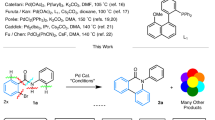Abstract
A novel methodology for `reverse-docking' a cationic peptide-based organocatalyst to a rigid anionic transition state (TS) model for the conjugate addition of azide to α,β-unsaturated carbonyl substrates is described. The resulting docking poses serve as simplified TS models for enantioselective catalysis. Molecular mechanics-based scoring and ranking of the docking poses, followed by clustering and structural analysis, reveal a clear energetic preference for docking to the S-enantiomeric azidation TS model, in agreement with experiment. Clear energetic trends emerged from docking the catalyst to both enantiomers of all six azidation TS models of this study. Structural analysis of the most favorable pose suggests a mechanism for enantioselective catalysis that is consistent with principles of molecular recognition, catalysis, and experimental data.
Similar content being viewed by others
Author information
Authors and Affiliations
Rights and permissions
About this article
Cite this article
Harriman, D.J., Deslongchamps, G. Reverse-docking as a computational tool for the study of asymmetric organocatalysis. J Comput Aided Mol Des 18, 303–308 (2004). https://doi.org/10.1023/B:JCAM.0000047813.47656.36
Issue Date:
DOI: https://doi.org/10.1023/B:JCAM.0000047813.47656.36




